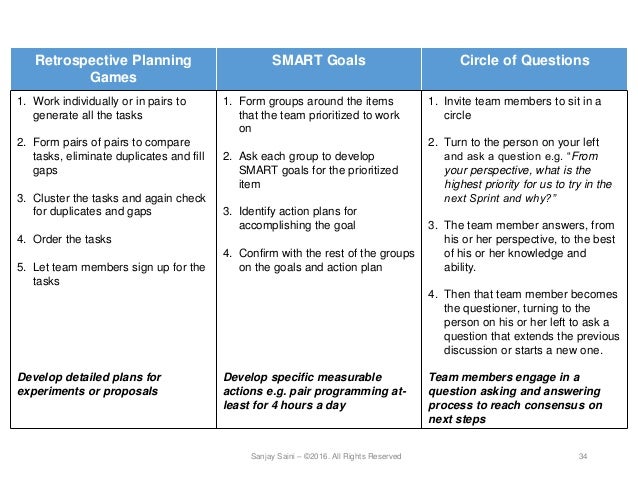

It can also help to add space at the end of the meeting for appreciating our team members, which creates an awesome space to shout out to people who really went above and beyond in the last sprint. You might ask yourselves these three questions: Our first foray into trying out a different topic doesn’t sound like a huge change, but simply adjusting the wording of the questions can force a team to think about their input in new ways. While elegant in its simplicity, a Retro structured around these three topics tends to sound a lot like the last two (or three or ten) meetings that asked these same questions. The typical format for a Retrospective is to have the team discuss three simple topics: what should we START doing, what should we STOP doing, and what should we CONTINUE doing.

Chocolate can often help.Īgile Marketing Retro Idea #1: What Went Well…

They should be at least an hour, and there’s nothing wrong with a two-hour retro. Make time for comprehensive retrospective meetings. It’s just the team talking about the team and its process.ĭon’t shortchange yourselves. There’s no burndown chart, no checklists, and no stakeholders. Retrospectives make it easier to get insight into the emotional and psychological factors that can drive a team to victory or doom it before the sprint even starts. Even with daily standup meetings we don’t know everything they’ve had to deal with during the past couple of weeks to get their share of the work done. This can make it difficult for agile team members to have real empathy for the other folks on our team. Sometimes it might be related - some people creating email, others ebooks, and others social media campaigns targeting the same personas - but other times there is little overlap among projects. The Importance of Agile Marketing Retrospectivesīefore we jump into some Retro types that have worked particularly well for a few teams we've worked with, I want to clarify why this meeting might be even more important for Agile marketing teams than for Agile development teams.Įven the most cohesive marketing team isn’t always going to be working on the same things. Keep yourselves accountable to identifying things your team can fix, and then assigning people to own those solutions. This is a time for the team to vent a little, but keep your eye on the prize, which is improving the process. Just make sure you don’t let your Retro degenerate into a blame game. Obviously sometimes people impact process, and that’s completely fair game to address. The discussion is about the process, not the people. The Scrum Master is welcome (and often runs the meeting), but the Product Owner and other management are not. No stakeholders or outside observers are allowed. Retrospective Rulesįor those who aren’t Retro veterans, here’s a quick overview of the “rules”: When you’re looking for a way to spice things up you can try these new Retrospective tactics. It’s up to the team to figure out how best to structure discussion so they can really dig in to their team and its processes.Īfter a few iterations it can be hard to keep the meeting fresh, but boring retros can very quickly lead to stagnant teams. While the topic is fairly standard, the format of the meeting is highly flexible. Regardless of what we discover, we understand and truly believe that everyone did the best job they could, given what they knew at the time, their skills and abilities, the resources available, and the situation at hand. Scrum teams will talk about their last sprint, while non-Scrum teams might discuss their latest project or simply the past few weeks or month.
#SPRINT RETROSPECTIVE QUESTIONS HOW TO#
The focus on getting at the heart of what’s working (so you can do more like that) and what’s broken (so you can fix it ASAP) makes retrospective meetings a non-negotiable part of any good Agile team.įor those unfamiliar with the concept, a Retrospective (or Retro) is a meeting during which an Agile team discusses the Agile process and how to make it better. Retrospectives hold a special place in all Agile processes.


 0 kommentar(er)
0 kommentar(er)
